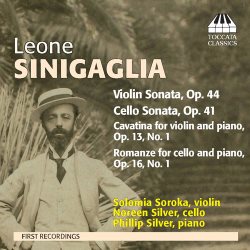|

Support us financially by purchasing
this through MusicWeb
for £10.50 postage paid world-wide.

|
Leone SINIGAGLIA (1868-1944)
Chamber Music
Violin Sonata in G major, Op.44 (1936) [28:47]
Romanze in D major for cello and piano, Op.16 No.1 (1898) [3:54]
Cavatina in G major for violin and piano, Op.13 No.1 (1902) [3:17]
Cello Sonata in C major, Op.41 (1923) [35:37]
Solomia Soroka (violin)
Noreen Silver (cello)
Phillip Silver (piano)
rec. July 2008, Patrych Sound Studios, Bronx, New York (Cello Sonata and Romanze) and November 2009, Rieth Recital Hall, Gosham College, Indiana (Cavatina and Violin Sonata)
TOCCATA CLASSICS TOCC 0025 [71:42]
It would be a pleasure to think that Leone Sinigaglia’s music might make inroads after many years of neglect. The Italian composer, who knew Brahms and was a student of Dvořák in Prague, was championed by diverse elite musicians – Furtwängler, Kreisler, Stokowski and Toscanini among them – but his compositions have long fallen into the kind of limbo that befalls many another once held in esteem. These chamber works are all heard, it seems, in premiere recordings.
The 1936 Violin Sonata was his last large-scale work – he was to die eight years later in Turin in 1944 whilst being arrested by the Nazis - Sinigaglia was Jewish. Bell peals and songful lyricism fuse with moments of gently pensive unease in broadly sonata form in the first movement. Maybe some of the passagework sounds a touch sequential but that is the only demerit, and that’s not a failing one could level at the ripe romanticism of the central slow movement. Here refined nostalgia is predicated on German models but is no less fresh for all that. The uplifting finale, albeit with a contrapuntal element – canonic imitation too – leads on to some strenuous passages amidst the elegant fluidity of the writing.
The Cello Sonata was written in 1923, contemporary therefore with the cello sonatas of Bax, Ireland and Delius. This time Sinigaglia prefers a four-movement structure, and the overall dimensions of the work are bigger than the later Violin Sonata.. The writing is quite busy at points but the slow winding down into simplicity illuminates the end of the opening movement rather touchingly. The Intermezzo is delightfully capricious, full of wit, whilst rich warmth suffuses the Adagio, a kind of barcarolle, and again rather wistful. This is a quality Sinigaglia often displays, and it is a singular one.
The small morceaux have been cleverly selected, one for each string instrument. We hear a somewhat melancholic Romanze for cello and piano, dating from 1898, and the Cavatina for violin from 1902 which reveals just the kind of lyric ease of which Sinigaglia was so astute a practitioner.
There is some but really not so very much trace of Italian folkloric writing in these string works – this was a strong component of his music but it’s less immediately apparent here. The performances are stylistically apt throughout, properly chamber-scaled, and not at all concertante-like. They make a good case for the sonatas though I can imagine rather more extravert tonal performances bringing other attributes to the fore.
Other than that, these elegant readings set a standard for future Sinigaglia performances, and I truly hope that more will follow the lead of the intrepid Solomia Soroka and Noreen and Philip Silver.
Jonathan Woolf
|
